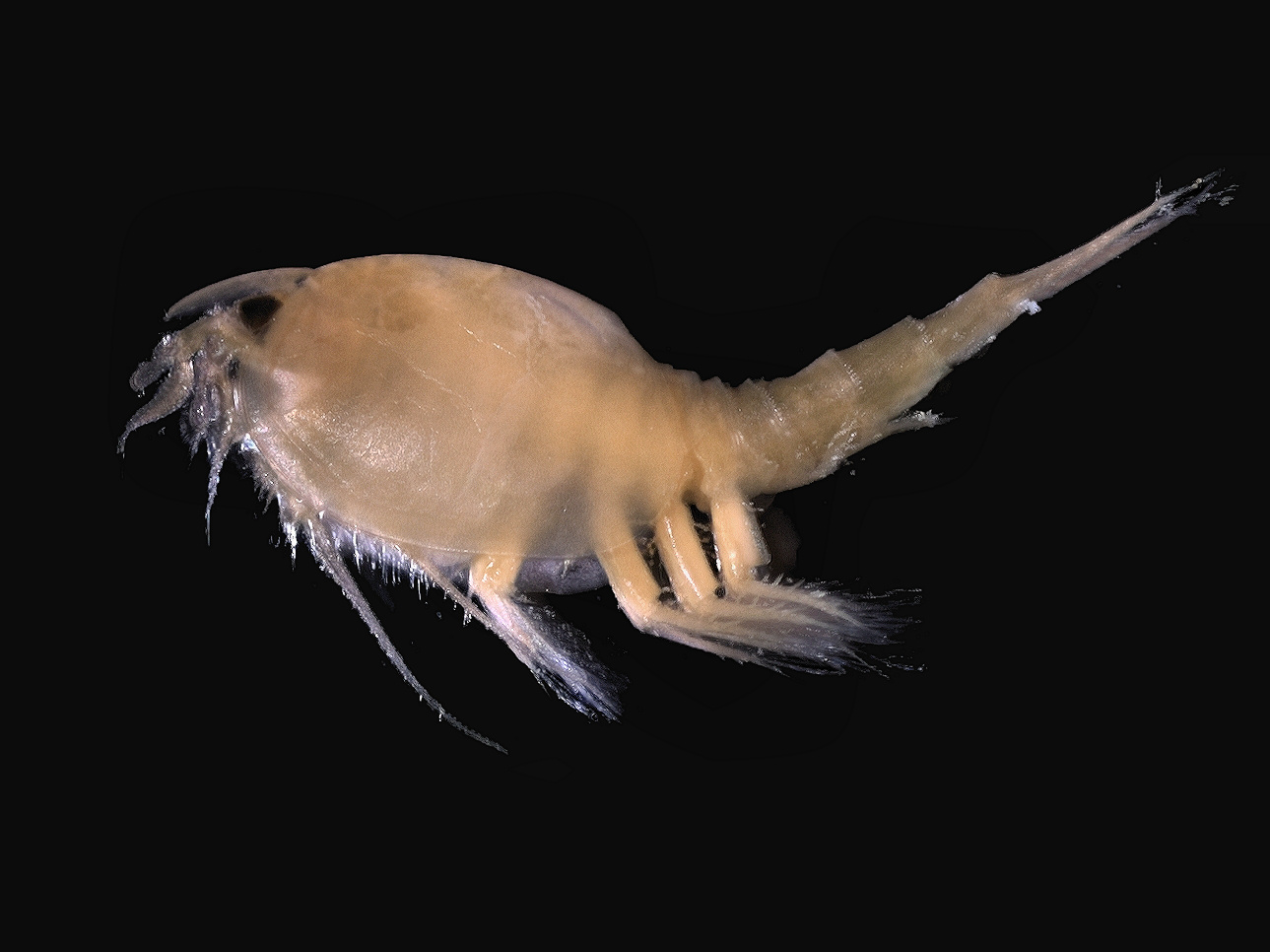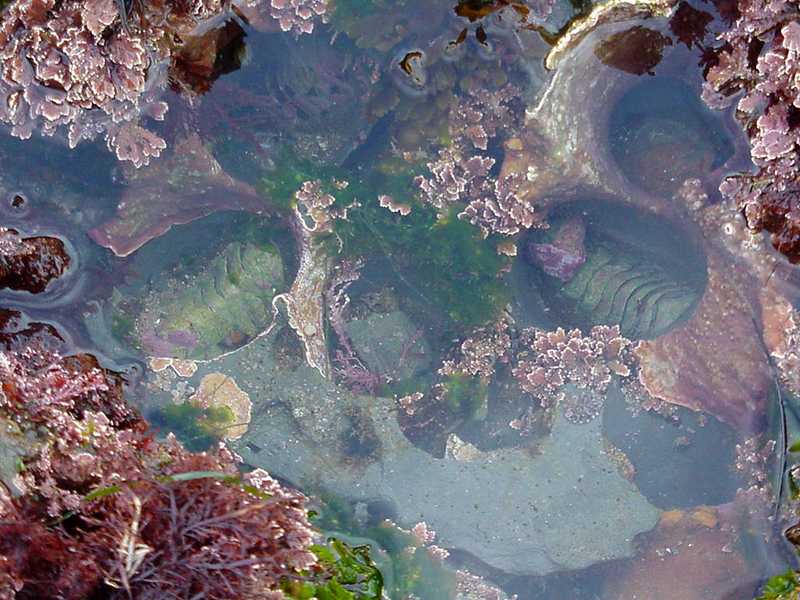|
Tanaidacea
The crustacean order Tanaidacea (known as tanaids) make up a minor group within the class (biology), class Malacostraca. There are about 940 species in this order. Description Tanaids are small, shrimp-like creatures ranging from in adult size, with most species being from . Their carapace covers the first two segments of the thorax. There are three pairs of limbs on the thorax; a small pair of maxillipeds, a pair of large clawed gnathopods, and a pair of pereiopods adapted for burrowing into the mud. The remaining six thoracic segments each bear a pair of pereiopods, and each of the first five abdomen, abdominal segments normally carry pleopods. The final segment is fused with the telson and carries a pair of uropods. The gills lie on the inner surface of the carapace. The thoracic limbs wash water towards the mouth, filtering out small particles of food with the mouthparts or maxillipeds. Some species actively hunt prey, either as their only food source, or in combination with ... [...More Info...] [...Related Items...] OR: [Wikipedia] [Google] [Baidu] |
Apseudidae
Apseudidae is a family of crustaceans belonging to the order Tanaidacea. Genera Genera: * ''Apseudes'' Leach, 1814 * ''Apseudopsis'' Norman, 1899 * ''Atlantapseudes'' Bacescu, 1978 References Tanaidacea Malacostraca families {{malacostraca-stub ... [...More Info...] [...Related Items...] OR: [Wikipedia] [Google] [Baidu] |
Malacostraca
Malacostraca is the second largest of the six classes of pancrustaceans behind insects, containing about 40,000 living species, divided among 16 orders. Its members, the malacostracans, display a great diversity of body forms and include crabs, lobsters, spiny lobsters, crayfish, shrimp, krill, prawns, isopods, amphipods, mantis shrimp, and many other less familiar animals. They are abundant in all marine environments and have colonised freshwater and terrestrial habitats. They are segmented animals, united by a common body plan comprising 20 body segments (rarely 21), and divided into a head, thorax, and abdomen. Etymology The name Malacostraca is . The word was used by Aristotle, who contrasted them with oysters, in comparison with which their shells are pliable. It was applied to this taxon by French zoologist Pierre André Latreille in 1802. He was curator of the arthropod collection at the National Museum of Natural History in Paris. This scientific name is misl ... [...More Info...] [...Related Items...] OR: [Wikipedia] [Google] [Baidu] |
Apseudellidae
''Apseudella'' is a monotypic genus of crustaceans belonging to the monotypic family Apseudellidae. The only species is ''Apseudella typica''. The species is found in Eastern Africa. References Tanaidacea Monotypic Malacostraca genera {{malacostraca-stub ... [...More Info...] [...Related Items...] OR: [Wikipedia] [Google] [Baidu] |
Telson
The telson () is the hindmost division of the body of an arthropod. Depending on the definition, the telson is either considered to be the final segment (biology), segment of the arthropod body, or an additional division that is not a true segment on account of not arising in the embryo from teloblast areas as other segments. It never carries any appendages, but a forked "tail" called the caudal furca may be present. The shape and composition of the telson differs between arthropod groups. Crustaceans In lobsters, Caridea, shrimp and other Decapoda, decapods, the telson, along with the uropods, forms the tail fan. This is used as a paddle in the caridoid escape reaction ("lobstering"), whereby an alarmed animal rapidly flexes its tail, causing it to dart backwards. Krill can reach speeds of over 60 cm per second by this means. The Induction period, trigger time to optical stimulus (physiology), stimulus is, in spite of the low temperatures, only 55 milliseconds. In th ... [...More Info...] [...Related Items...] OR: [Wikipedia] [Google] [Baidu] |
Tanaidomorpha
Tanaidomorpha is a suborder of malacostracan crustacean Crustaceans (from Latin meaning: "those with shells" or "crusted ones") are invertebrate animals that constitute one group of arthropods that are traditionally a part of the subphylum Crustacea (), a large, diverse group of mainly aquatic arthrop .... References Tanaidacea Crustaceans described in 1980 {{Malacostraca-stub ... [...More Info...] [...Related Items...] OR: [Wikipedia] [Google] [Baidu] |
Anthracocarididae
''Anthracocaris'' is an extinct genus of crustaceans which lived during the Early Carboniferous period in Scotland. It is the only genus in the family Anthracocarididae. The genus contains a single species, ''A. scotica'', which was first named as a species of '' Palaeocaris'' in 1882, but later recognized to belong in a separate genus. Discovery and naming Fossil remains of ''Anthracocaris'' were first studied by British geologist Ben Peach, who analyzed around 30 specimens of this animal which were collected by A. Macconochie in Eskdale, Scotland. Recognizing that these fossils represent a new species, Peach named this species '' Palaeocaris scoticus'' in 1882, believing it was the first species of ''Palaeocaris'' to be discovered in Britain. In 1908, Peach published a monograph on the Carboniferous crustaceans of Scotland in which he once again described this species, noting that there exist many additional specimens of it aside from those he studied for its initial publicat ... [...More Info...] [...Related Items...] OR: [Wikipedia] [Google] [Baidu] |
Hermaphrodite
A hermaphrodite () is a sexually reproducing organism that produces both male and female gametes. Animal species in which individuals are either male or female are gonochoric, which is the opposite of hermaphroditic. The individuals of many taxonomic groups of animals, primarily invertebrates, are hermaphrodites, capable of producing viable gametes of both sexes. In the great majority of tunicates, mollusks, and earthworms, hermaphroditism is a normal condition, enabling a form of sexual reproduction in which either partner can act as the female or male. Hermaphroditism is also found in some fish species, but is rare in other vertebrate groups. Most hermaphroditic species exhibit some degree of self-fertilization. The distribution of self-fertilization rates among animals is similar to that of plants, suggesting that similar pressures are operating to direct the evolution of selfing in animals and plants. A rough estimate of the number of hermaphroditic animal species ... [...More Info...] [...Related Items...] OR: [Wikipedia] [Google] [Baidu] |
Brood Pouch (Peracarida)
The marsupium or brood pouch, is a characteristic feature of Peracarida, including the orders Amphipoda, Isopoda, and Cumacea Cumacea is an order (biology), order of small marine crustaceans of the superorder Peracarida, occasionally called hooded shrimp or comma shrimp. Their unique appearance and uniform body plan makes them easy to distinguish from other crustaceans. .... It is an egg chamber formed by oostegites, which are appendages that are attached to the coxae (first segment) of the first pereiopods. Females lay their eggs directly into the brood chamber, and the young will develop there, undergoing several moults before emerging as miniature adults referred to as mancae. Males have no marsupium. References {{malacostraca-stub Crustacean anatomy ... [...More Info...] [...Related Items...] OR: [Wikipedia] [Google] [Baidu] |
Manca
The manca (plural: ''mancae'') is the post-larval juvenile in some crustaceans. The term is derived from Latin ''mancus'', meaning "defective, imperfect." The manca stage is the defining characteristic of a clade called Mancoida which comprises all the members of the Peracarida except the Mysidacea and the Amphipoda. Mancae closely resemble the adult form, but for the absence of the last pair of pereiopods. In some isopods, specifically the family Gnathiidae, the manca stage is a parasite Parasitism is a Symbiosis, close relationship between species, where one organism, the parasite, lives (at least some of the time) on or inside another organism, the Host (biology), host, causing it some harm, and is Adaptation, adapted str ... of fish, and is also known as the praniza. References Crustaceans Developmental biology Larvae {{crustacean-stub ... [...More Info...] [...Related Items...] OR: [Wikipedia] [Google] [Baidu] |
Benthos
Benthos (), also known as benthon, is the community of organisms that live on, in, or near the bottom of a sea, river, lake, or stream, also known as the benthic zone.Benthos from the Census of Antarctic Marine Life website This community lives in or near marine or freshwater sedimentary environments, from tidal pools along the , out to the continental shelf, and then down to the [...More Info...] [...Related Items...] OR: [Wikipedia] [Google] [Baidu] |
World Register Of Marine Species
The World Register of Marine Species (WoRMS) is a taxonomic database that aims to provide an authoritative and comprehensive catalogue and list of names of marine organisms. Content The content of the registry is edited and maintained by scientific specialists on each group of organism. These taxonomists control the quality of the information, which is gathered from the primary scientific literature as well as from some external regional and taxon-specific databases. WoRMS maintains valid names of all marine organisms, but also provides information on synonyms and invalid names. It is an ongoing task to maintain the registry, since new species are constantly being discovered and described by scientists; in addition, the nomenclature and taxonomy of existing species is often corrected or changed as new research is constantly being published. Subsets of WoRMS content are made available, and can have separate badging and their own home/launch pages, as "subregisters", such as th ... [...More Info...] [...Related Items...] OR: [Wikipedia] [Google] [Baidu] |
Carboniferous
The Carboniferous ( ) is a Geologic time scale, geologic period and System (stratigraphy), system of the Paleozoic era (geology), era that spans 60 million years, from the end of the Devonian Period Ma (million years ago) to the beginning of the Permian Period, Ma. It is the fifth and penultimate period of the Paleozoic era and the fifth period of the Phanerozoic eon (geology), eon. In North America, the Carboniferous is often treated as two separate geological periods, the earlier Mississippian (geology), Mississippian and the later Pennsylvanian (geology), Pennsylvanian. The name ''Carboniferous'' means "coal-bearing", from the Latin ("coal") and ("bear, carry"), and refers to the many coal beds formed globally during that time. The first of the modern "system" names, it was coined by geologists William Conybeare (geologist), William Conybeare and William Phillips (geologist), William Phillips in 1822, based on a study of the British rock succession. Carboniferous is the per ... [...More Info...] [...Related Items...] OR: [Wikipedia] [Google] [Baidu] |





